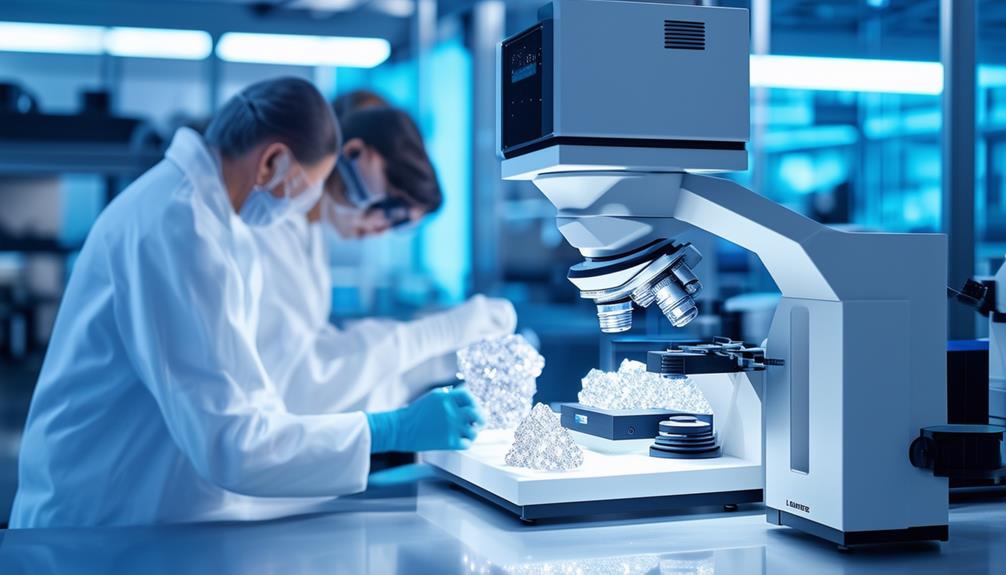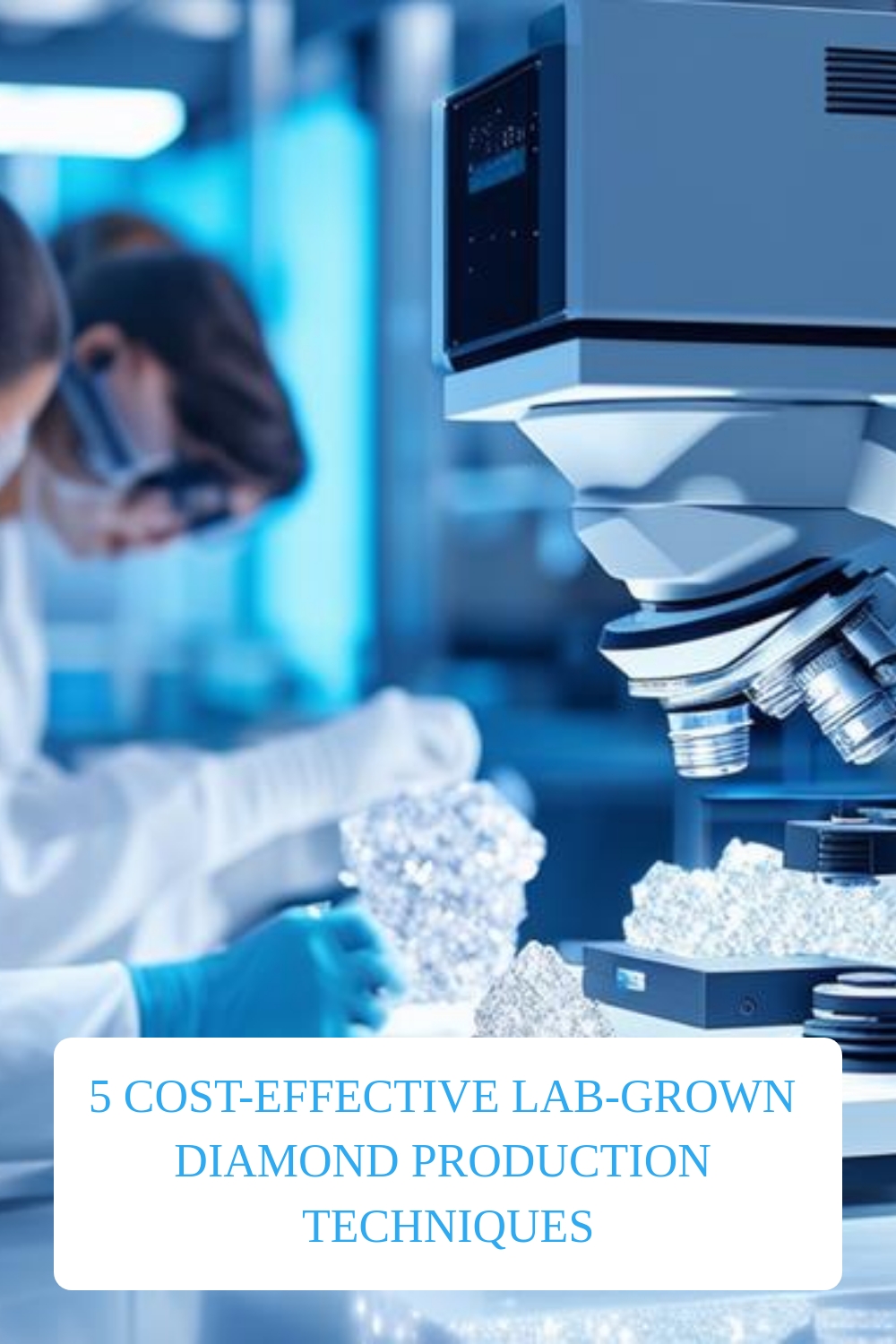Article Contents
In the field of synthetic diamond production, five cost-effective techniques have emerged as leaders.
The High Pressure High Temperature (HPHT) method uses extreme pressures and temperatures to convert graphite into diamonds, employing advanced presses designed for this purpose.
In contrast, the Chemical Vapor Depression (CVD) process involves the deposition of carbon-rich gases on a substrate, resulting in high-quality, colourless diamonds suitable for jewellery and industrial applications.
Utilising microwave energy, the microwave plasma technology efficiently promotes diamond growth, reducing production costs.
Detonation synthesis creates small, yet exceptionally hard diamonds by controlled explosions, offering rapid production rates.
Lastly, ultrasound cavitation utilises high-frequency sound waves to meticulously form well-structured diamonds.
Each technique offers unique benefits and efficiencies, making them valuable for specific applications in the diamond industry.
Key points
- The Chemical Vapour Deposition (CVD) technique uses carbon-rich gases to produce diamonds sustainably and cost-effectively.
- Microwave Plasma Technology enhances diamond quality and boosts production efficiency, thereby reducing overall costs.
- The Detonation Synthesis Method rapidly produces nanodiamonds using controlled explosions, offering a quick and cost-effective production method.
- Ultrasound Cavitation Process employs high-frequency sound waves to create diamonds, ensuring an economical and sustainable approach.
- High Pressure High Temperature (HPHT) Diamond Production method transforms graphite into diamonds using specialised presses and pre-selected seeds, optimising the conversion process.
HPHT Diamond Production
HPHT (High Pressure High Temperature) diamond production is a process developed in the 1950s that replicates the natural conditions under which diamonds form. This method uses extreme temperatures and pressures to transform carbon sources like graphite into diamonds, closely mirroring the natural growth of these gems deep within the Earth.
In the HPHT method, graphite is placed in a metal flux, which dissolves the carbon and facilitates its deposition around a pre-selected diamond seed. These seeds are essential as they define the structural and qualitative characteristics of the resulting synthetic diamond. The entire operation occurs within specialised presses—such as belt, cubic, or split-sphere presses—that can endure the requisite high pressures and temperatures. The time the carbon source spends under these conditions influences the diamond's size and quality, offering precise control over the production process.
This technique allows for the creation of diamonds that can be customised to meet specific requirements, providing a versatile and reliable means of synthesising high-quality diamonds.
CVD Diamond Technique
Transitioning from the High Pressure High Temperature (HPHT) method, the Chemical Vapor Deposition (CVD) technique offers an alternative, innovative means for diamond synthesis in laboratory environments. In the CVD process, a chamber is charged with carbon-rich gases, primarily methane and hydrogen. These gases are crucial for diamond creation as they are ionised into plasma using methods typically excluding microwaves. This ionisation facilitates the deposition of carbon atoms onto a substrate, building the diamond structure layer by layer.
The CVD method's highly controlled growth environment ensures the production of pure diamonds, critical for obtaining colourless or near-colourless diamonds. These diamonds are prized in the jewellery industry for their exceptional brilliance and clarity. Moreover, the CVD technique supports the development of large, high-quality diamonds, making it ideal for various high-end applications.
The efficiency and scalability of the CVD process contribute to its cost-effectiveness, enabling the consistent production of uniform diamonds at lower costs compared to traditional methods. Consequently, this method supports a sustainable production model that aligns with increasing consumer demand for ethically sourced, superior-quality diamonds. This integration of advanced technology with traditional aesthetic values results in a harmonious blend of innovation and timeless elegance in diamond production.
Microwave Plasma Technology
Microwave Plasma Technology enhances the lab-grown diamond synthesis process by utilising microwave energy to create a plasma ball. This environment decomposes carbon gases, facilitating the growth of diamonds. The technology allows for precise control over factors such as temperature and pressure, which are crucial for ensuring the quality and uniformity of the diamonds produced.
This method not only improves diamond quality but also increases the efficiency of the production process. By speeding up the growth cycles, Microwave Plasma Technology reduces production costs, making high-quality diamonds more affordable and accessible. This approach democratises the luxury of diamonds, making them available to a wider audience at a lower cost.
Microwave Plasma Technology represents a significant advancement in gemological technology, maintaining the allure of diamonds while adhering to ethical standards. It sets a new benchmark in the field, combining technological innovation with sustainability and accessibility.
Detonation Synthesis Method
The detonation synthesis method utilises controlled explosions to create the extreme conditions necessary for diamond formation, producing nanodiamonds in mere microseconds. This method compresses carbon materials with shock waves under high heat, resulting in diamonds that are exceptionally small, pure, and hard.
Key features of the detonation synthesis method include:
- Rapid Production: Diamonds are synthesised in microseconds, significantly faster than traditional methods.
- High-Quality Output: The resulting nanodiamonds are distinguished by their superior hardness and purity.
- Scalability: The method can be scaled up to meet large-scale industrial production needs efficiently.
- Versatility: Nanodiamonds have unique properties that are applicable to advanced technologies across various industries.
This technique enhances design and functional flexibility, providing industries with advanced materials that enhance innovation and practical application. The detonation synthesis method is pivotal in advancing synthetic diamond technologies and revolutionising manufacturing efficiency and product quality.
Ultrasound Cavitation Process
Transitioning from the high-energy detonation synthesis method, we now delve into the ultrasound cavitation process, which utilises high-frequency sound waves to produce lab-grown diamonds. This method involves the creation of nanoscale bubbles in a liquid medium, which implode and generate intense localised heat and pressure. This critical phenomenon facilitates the breakdown of materials, crucial for achieving the desired particle size in diamond synthesis.
The ultrasound cavitation process is not only pivotal for generating diamond nanoparticles but also enhances the precision in cutting and shaping these stones. By allowing for manipulation at a microscopic level, this technique improves the structural quality of the diamonds. It is also recognised for its cost-effectiveness and environmental sustainability, meeting the contemporary demands for responsible manufacturing practices.
Frequently Asked Questions
What is the best method for lab-grown diamonds?
The optimal method for producing lab-grown diamonds effectively balances advanced technology and environmental sustainability. The choice of technique depends on the specific end-use, prioritising either high aesthetic qualities for gem applications or cost-effective production methods for industrial purposes.
Are lab-grown diamonds cheaper to produce?
Lab-grown diamonds are usually cheaper to produce than mined diamonds. This cost-effectiveness is because of scalable production methods and reduced environmental harm. As a result, consumers can choose these sustainable alternatives without compromising on quality or ethical concerns.
Which Lab Grown Diamond Process Is Better?
Deciding between HPHT (High Pressure High Temperature) and CVD (Chemical Vapor Deposition) methods for creating lab-grown diamonds primarily hinges on the desired quality, specific usage, and environmental impact considerations. Advances in technology can sway this choice, allowing individuals to choose a method that best aligns with their personal and ethical preferences.
Is making lab-grown diamonds profitable?
The manufacturing of lab-grown diamonds is lucrative because of favourable market trends and high investment returns. This profitability is also reinforced by a consumer preference for ethical products, which encourages sustainable practices and provides more options for consumers.
Summary
In the pursuit of sustainable luxury, modern techniques for creating lab-grown diamonds showcase the remarkable capability to replicate the natural formation of diamonds.
Unlike ancient alchemists who unsuccessfully attempted to convert lead into gold, today's scientists effectively use advanced technologies to convert carbon-rich gases into high-quality diamonds.
This process not only makes diamonds more accessible but also introduces an environmentally friendly alternative to traditional diamond mining.
As these technologies advance, they promise a future where luxury is both scientifically achievable and ecologically responsible, blending opulence with innovation in a trustworthy and consistent manner.



